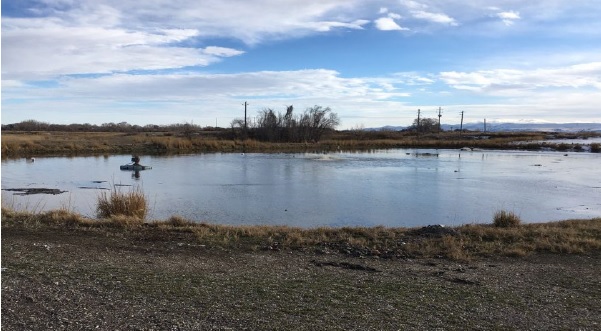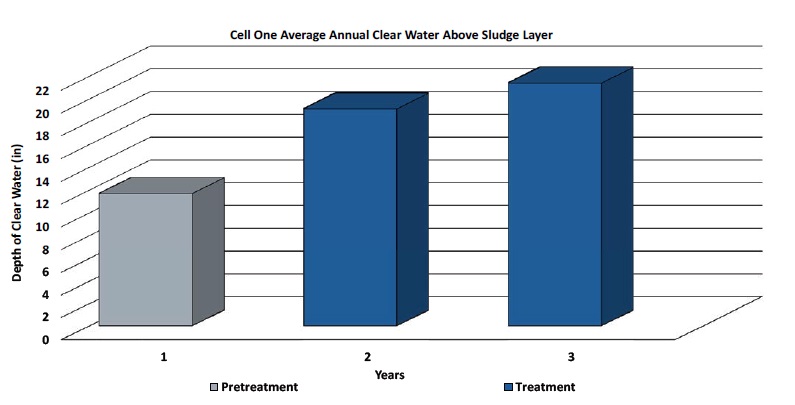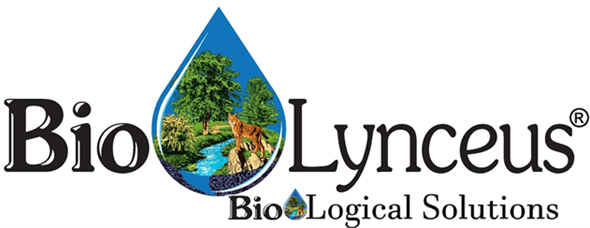One of the most persistent challenges in lagoon wastewater treatment is solids (sludge) management. Lagoon systems are designed to reduce organic solids during wastewater
processing. Built up sludge is typically dredged from lagoon systems with heavy equipment. Once removed, sludge is dewatered and hauled to a disposal site. This process can cost $300 to $500 dollars per dry ton of solids.
Bioaugmentation is an effective method for reducing sludge in lagoon systems. By implementing concentrated cultures of bacteria (from natural soils and sediments) in these processes, treatment biomass is increased which can improve the efficiency of solids degradation.1
This process is also called ProBiotic Dredging®. BioLynceus® ProBiotic Scrubber® II (PBII) was used in the following case study to reduce the quantity of solids in a municipal lagoon system.

Figure 1. Case study lagoon system. PBII was injected into the collection system to reduce accumulated solids in the treatment cells.
A publicly owned treatment works (POTW) in a town of 2,700 people was experiencing sludge accumulation in their lagoon system. The three treatment cells averaged 0.3 MGD wastewater flows (with some seasonal variability). The solids which built up in the process would require dredging if they were not reduced another way.
The head wastewater operator learned about ProBiotic Dredging® in a wastewater training. ProBiotic Dredging® can be very effective for reducing organic solids in lagoon systems. The operator decided to propose this solution to the city council.
The council agreed to augment their system with BioLynceus® microbiology to reduce dredging costs. A treatment regimen of PBII was added to several high points in the collection system ahead of the influent to the first cell. By implementing PBII in the system, the abundance of solids degrading organisms were increased.

Figure 2. Average annual depth of clear water above the solid sludge profile in the first treatment cell. Depth measurements were collected at 12 locations around the lagoon. Increasing trends in average annual depth of clear water indicated an organic solids reduction via ProBiotic Dredging®.
Changes in sludge depth were estimated by determining the depth of clear water to the top of the sludge layer before and during treatment. Measurements were taken in the first treatment cell in fall the year prior to treatment and the next two years with treatment. After a year of PBII applications, the depth of clear water above the solid
sludge increased from about 12 to 19 inches (Figure 2).
This change indicated a seven-inch reduction in sludge depth over the year. During the second year of treatment, the average depth of clear water in the cell was increased to about 22 inches. The sludge layer was biologically degraded by an additional three inches over this time.
The POTW did not need to dredge the lagoons to maintain proper treatment holding capacity. The quality of wastewater processed remained high while solids were biologically degraded. The lagoon facility continues to treat with BioLynceus® PBII.
BioLynceus® ProBiotic Scrubber® II helps reduce solids in wastewater lagoon systems.
1 Gerardi, M. (2016). Wastewater Bioaugmentation and Biostimulation. Lancaster, Pennsylvania: DEStech Publications, Inc. Pp.117. https://www.amazon.com/Wastewater-Bioaugmentation-Biostimulation-Michael-Gerardi/dp/1932078789
